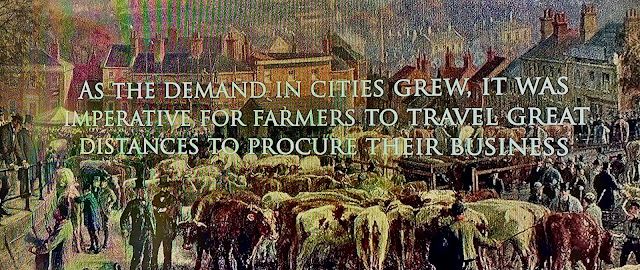Meat in the City (The Expanding Market Place)
Whilst this image above is not of Birmingham, the scene, setting and statement are easily qualified for any major city in the UK.
We get a sense from this beast market scene of the hustle between traders, customers, and local authorities, together with the imagined yet pervasive odours, noise and organised chaos from the herded beasts. An earthy atmosphere indeed, surrounded by inner-city dwellers, living with the weekly incursion of out-of-town droves, including people, cattle, sheep, pigs and geese as well as numerous other livestock. Prior to the railways in Birmingham, around 1838, these animals would have travelled hundreds of miles in some cases, especially the cattle from Anglesey, an arduous task for man and beast, but a necessary one that had occurred and prevailed over many hundreds of years.
I envision a somewhat hostile setting with people striving by fair means or foul to make a profit and/or a living, hoping for a top price or a bargain using wit and banter and a language of their own, often used to confuse the market authority.
The top hat and coat-tailed gentry are evident, bankers maybe, with an overview of business and quality of merchandise, making a weekly visit, part social, part business, part escape from other daily demands.
The round hat and smock of the Drover with a stick can be seen, managing the beast order with skill and guile, eager to get business done, securing the funds and catching up with gossip at The Drovers Arms on Bradford Street.
Other hats, including bowlers and caps, suggest personnel with other businesses linked to the marketplace, no doubt sometimes devious in its nature, a place to find the renowned scally, the outright thug, the joker and a place to meet the like-minded. The hat serves as a mode of identification, purpose and intention.
 |
| The Drover statue at Llandovery |
 |
| Slaughterhouses near St Martins |
 |
| If not Birmingham, this would have been a common mid-19th century scene in many cities. |







Comments
Post a Comment